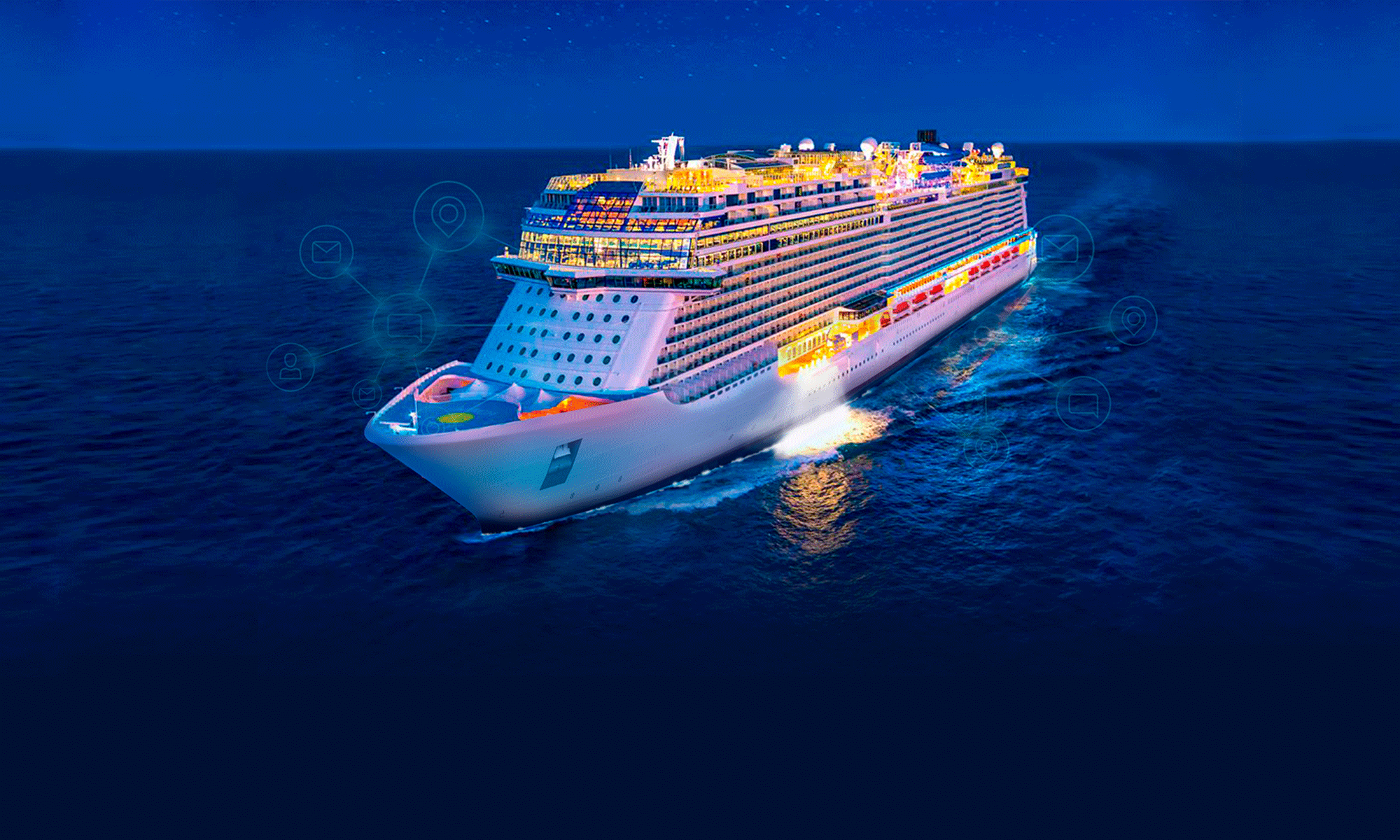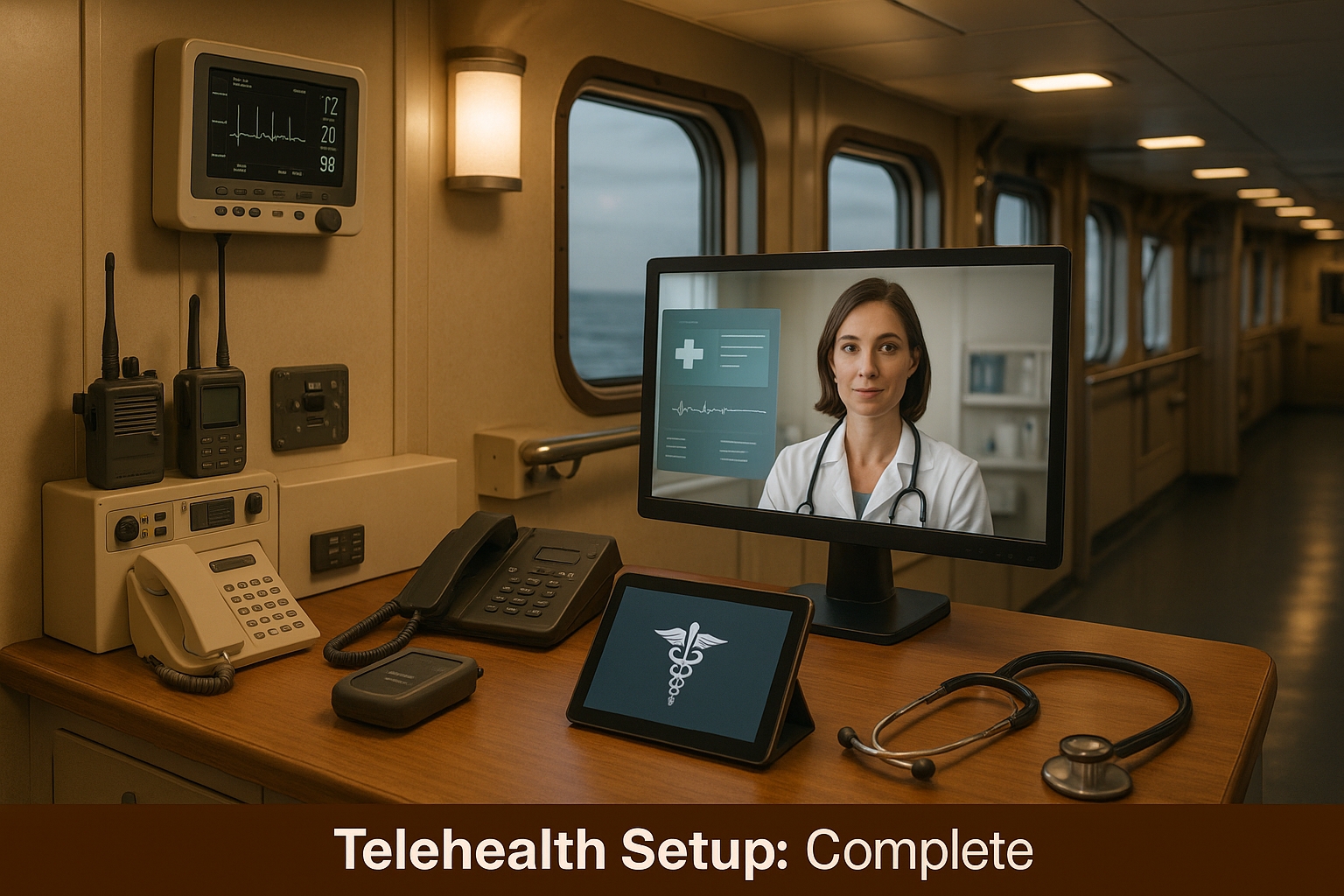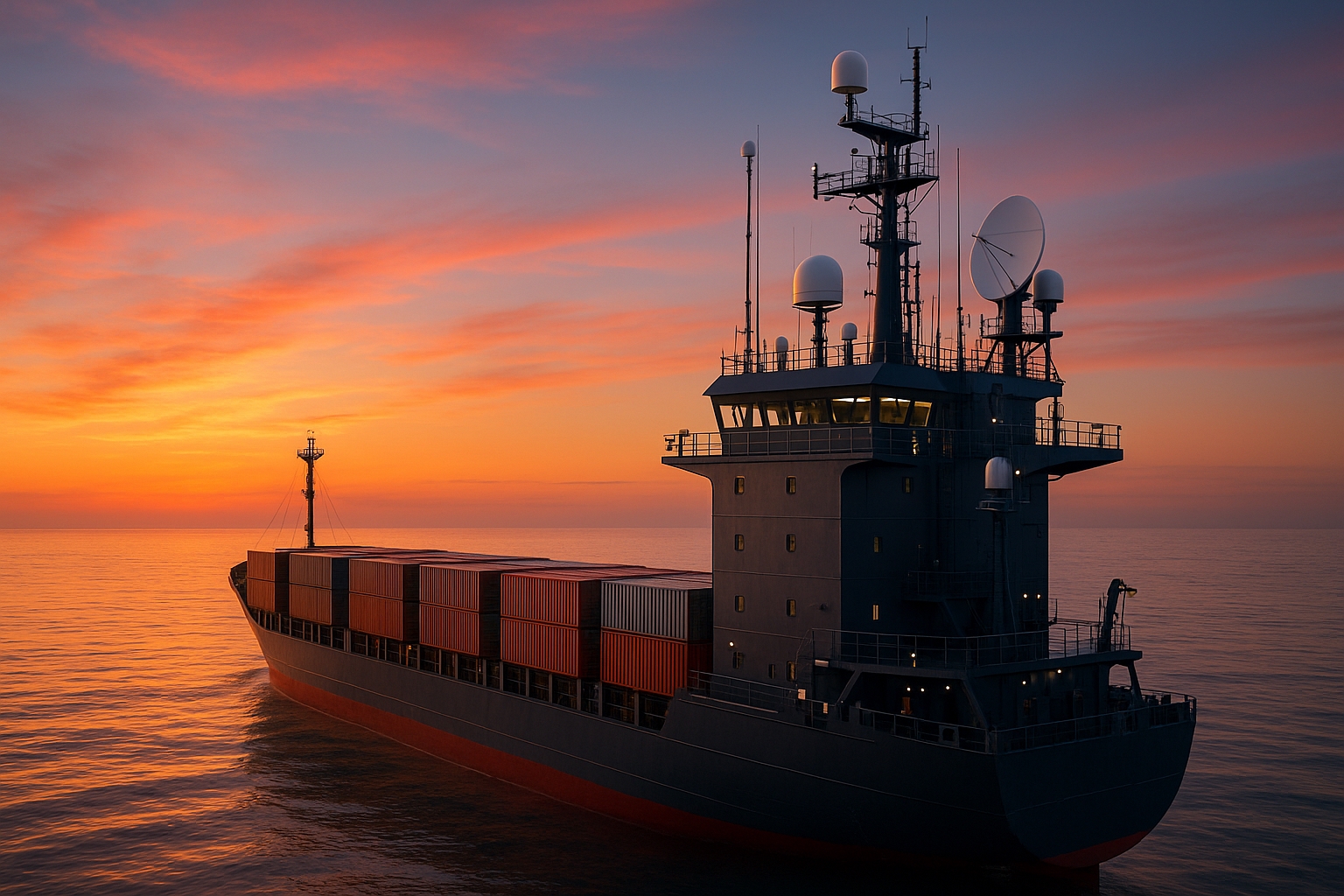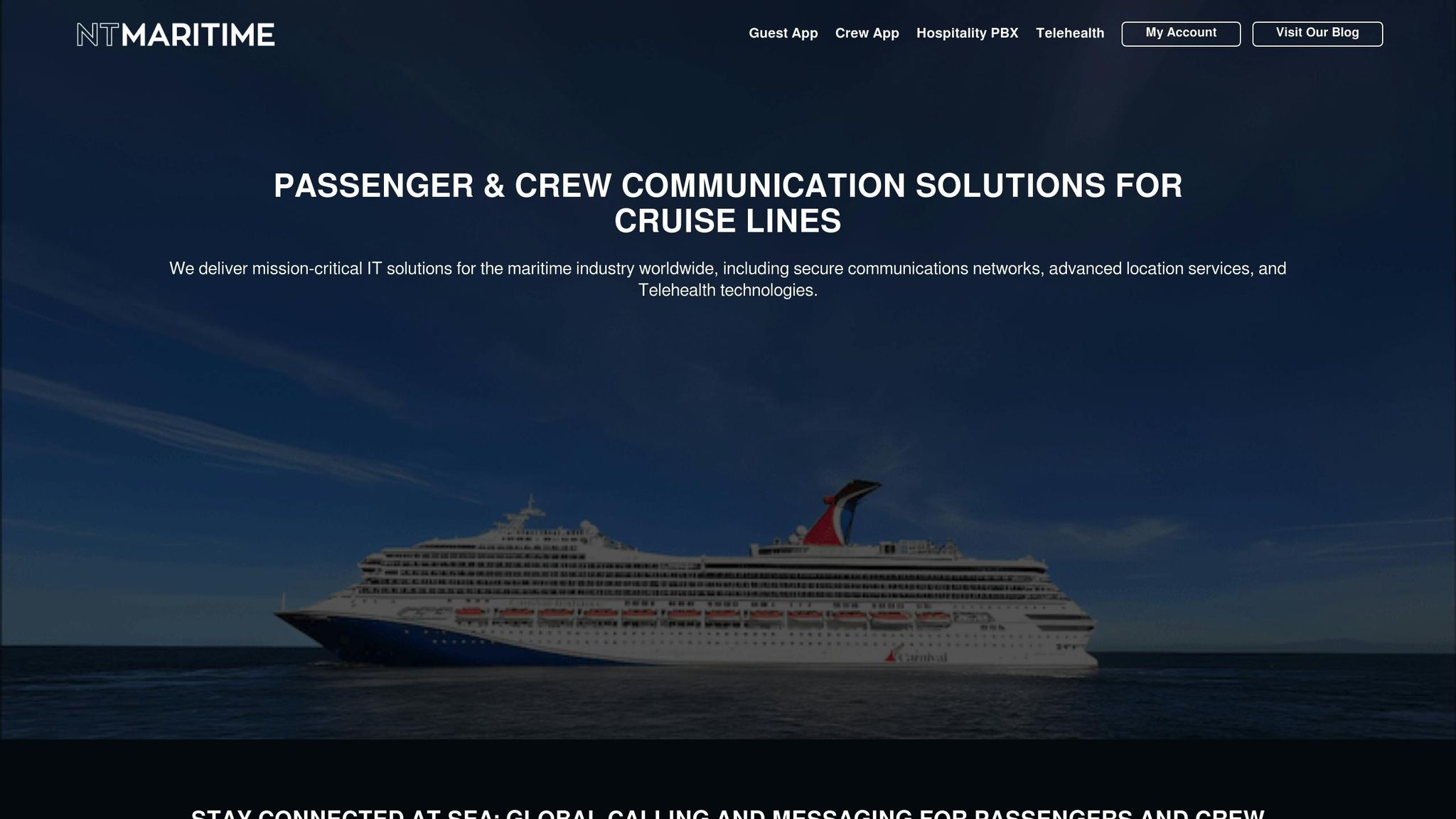Ship telehealth systems ensure medical care is accessible, even in remote maritime environments. These setups connect vessels to onshore medical teams using advanced communication tech for real-time consultations and health monitoring. Here’s what you need to know:
-
Core Components:
- Hardware: High-definition cameras, portable diagnostic tools, medical-grade tablets, and vital sign monitors.
- Software: HIPAA-compliant platforms with offline functionality, multi-language support, and integration with ship systems.
- Connectivity: Satellite internet, redundancy systems, and secure networks for uninterrupted communication.
-
Implementation Steps:
- Assess your ship’s medical needs and onboard resources.
- Collaborate with stakeholders, including medical and IT teams.
- Train crew members on using telehealth tools and establish emergency protocols.
-
Compliance & Security:
- Follow maritime health regulations.
- Protect data with encryption, VPNs, and access controls.
Telemedicine at Sea: Digital Technology Making a Difference
Core Requirements for Setting Up Ship Telehealth Systems
Setting up telehealth systems on ships comes with its own set of challenges. Salt air corrosion, limited bandwidth, and the constant motion of the vessel create hurdles that land-based systems simply don’t encounter. To make it work, you need reliable hardware, secure software, and a steady internet connection – all working together to deliver healthcare in tough maritime conditions.
Let’s dive into the hardware essentials that make maritime telehealth possible.
Required Hardware for Maritime Telehealth
Telehealth hardware for ships must be tough enough to handle harsh sea conditions while still delivering precise medical results. Here’s what’s essential:
- High-definition cameras: These are crucial for remote consultations, allowing doctors onshore to assess patients accurately. They need to be built for marine environments, with anti-corrosion coatings and shock-resistant designs to endure the ship’s constant movement.
- Portable diagnostic tools: Devices like Bluetooth-enabled digital stethoscopes let specialists listen to heart and lung sounds in real time. Telehealth-friendly ECG machines can instantly send cardiac data, while portable ultrasound devices provide immediate imaging during emergencies.
- Medical-grade tablets and computers: These act as the command center for telehealth operations. They need bright, high-resolution screens that work in both dim medical bays and bright outdoor areas. Responsive touchscreens (even with gloves on) and enough processing power to handle video calls and data transmission are key.
- Vital signs monitors: These devices track and send real-time data like blood pressure, heart rate, oxygen levels, and temperature to shore-based medical teams. Wireless connectivity and battery backups are must-haves to keep them running even during power interruptions.
- Secure storage solutions: Protecting sensitive medical equipment is critical. Refrigeration units ensure temperature-sensitive medications stay effective, while waterproof containers shield electronics from moisture and salt spray.
Selecting Telehealth Software
The software is the backbone of ship telehealth, connecting crews to medical professionals and securely managing health data. Here’s what to look for:
- HIPAA compliance: The software must encrypt all communications to keep patient data safe from cyber threats. This is non-negotiable for protecting sensitive medical information.
- User-friendly design: For crew members without medical training, intuitive navigation and easy-to-use controls are essential. Features like voice-activated commands can be a lifesaver during emergencies when hands-free operation is needed.
- Integration with ship systems: The software should work seamlessly with existing tools, like electronic health records and diagnostic equipment, to streamline data flow and avoid duplicate entries.
- Offline functionality: Connectivity can be spotty at sea, so the software should store critical resources like medical protocols and drug interaction databases locally. Once the connection is restored, it should automatically sync any updates with shore systems.
- Multi-language support: Ships often have diverse crews, so offering interfaces in multiple languages and real-time translation for consultations is vital for clear communication.
Connectivity Solutions for Ships
Reliable communication is the lifeline of telehealth at sea, ensuring that ships stay connected to shore-based medical facilities. Here’s how to make it work:
- Satellite internet systems: These are the primary connection for telehealth. Modern VSAT systems provide faster speeds and lower latency, enabling smooth video consultations and rapid data transmission. Speeds of up to 220 Mbps download and 40 Mbps upload with latency under 99ms make real-time medical care feasible.
- Redundant communication systems: Backup options like multiple satellite providers, cellular networks near shore, or radio-based data transmission ensure connectivity even if the primary system fails. The system should automatically switch to the best available option to maintain uninterrupted communication.
- Quality of Service (QoS) management: During medical emergencies, QoS prioritizes telehealth traffic over other internet usage, ensuring that consultations and data transfers happen without delays.
- Antenna stabilization systems: These systems use gyroscopic technology to keep satellite dishes aligned, even in rough seas. This ensures a stable connection during critical moments, especially in severe weather when emergencies are most likely.
- Network security: Protecting telehealth communications from cyber threats is crucial. Firewalls designed for maritime environments, VPNs for medical traffic, and intrusion detection systems safeguard sensitive data. Regular updates and monitoring keep these defenses strong against evolving threats.
Step-by-Step Guide to Implementing Telehealth on Ships
Setting up telehealth services on ships goes beyond just installing fancy equipment. It’s about understanding your crew’s health needs, coordinating efforts across teams, and creating protocols that actually work in the unique maritime environment.
Evaluating Medical Needs and Resources
Start by taking a close look at the medical challenges your vessel typically faces. For instance, cargo ships might deal with machinery injuries, while passenger vessels could see more cardiac events or mental health concerns. Each type of vessel has its own set of needs.
Next, assess what you already have onboard – this includes medical equipment, medications, and the crew’s level of medical training. This evaluation will help you figure out which telehealth tools make the most sense and highlight any additional training your crew might need.
Think about where your ship operates. If you’re navigating remote waters like the North Pacific or Southern Ocean, you’ll likely need more advanced telehealth capabilities compared to vessels with frequent port stops. Don’t forget to factor in the length of your voyages, the size of your crew, and whether you carry passengers.
Dive into your ship’s incident logs to spot recurring medical issues. For example, if cardiac events are common, investing in ECG devices might be a priority. Similarly, if injuries happen often, trauma care tools should be on your list.
Once you’ve outlined your needs, it’s time to bring in the right people to make it all happen.
Working with Stakeholders
Implementing telehealth successfully requires teamwork. You’ll need input from various departments and external partners. Start by assembling a project team that includes representatives from medical staff, IT operations, ship management, and shore-based support teams.
The medical team’s role is to outline clinical needs and workflows. They’ll determine which diagnostic tools are essential, what types of consultations are most likely to be needed, and how telehealth will fit into your current medical protocols. If your ship doesn’t have dedicated medical staff, consider working with a maritime medical advisory service for expert advice.
Your IT team will need to ensure that telehealth systems integrate seamlessly with the ship’s existing networks. Reliable connectivity is crucial for smooth video consultations, so they’ll need to address any potential issues with bandwidth or latency.
Ship management will handle the practicalities – approving budgets, setting up training schedules, and coordinating with regulatory bodies. Some flag states have specific requirements for telehealth equipment, especially when it’s tied to emergency medical systems, so compliance is key.
Don’t forget to establish partnerships with shore-based medical facilities that offer round-the-clock telehealth services. These facilities should be familiar with maritime operations and provide clear protocols for emergency consultations, routine medical advice, and even prescription approvals.
Training and Emergency Protocols
Once you’ve coordinated with stakeholders, the next step is to finalize training programs and emergency procedures. Training is what transforms telehealth equipment from just another gadget into a reliable, life-saving resource.
Start with basic training for all crew members. Everyone should know how to initiate a telehealth session, operate diagnostic tools like digital thermometers and blood pressure monitors, and troubleshoot common tech issues. This ensures telehealth remains accessible even when the designated medical personnel are unavailable.
For crew members with medical responsibilities, provide more advanced training. Hands-on practice with equipment like digital stethoscopes and portable ECG machines is essential. Simulated consultations with shore-based doctors can help build confidence and identify any communication hurdles.
Emergency protocols are another critical piece of the puzzle. Develop clear guidelines that outline when and how to use telehealth services. Decision trees can be especially helpful, guiding crew members on whether a situation requires immediate telehealth assistance, can wait for routine advice, or calls for an emergency evacuation. These protocols should also address different connectivity scenarios, from full broadband access to limited satellite communication.
Make sure your crew is trained on proper documentation and data handling. Medical records need to be secure and private, especially when non-medical personnel are involved. Train your team on HIPAA compliance and secure data management practices.
Regular emergency drills are a must. These exercises test both the technical systems and the crew’s readiness, allowing you to identify and fix any gaps. Scenarios could include managing a cardiac event during rough seas or handling injuries in low-connectivity areas that require input from multiple specialists.
Finally, maintenance is key to keeping your telehealth system running smoothly. Saltwater environments can be tough on electronics, so regular cleaning, calibration, and testing are essential. Train your crew to handle basic maintenance tasks and recognize when professional servicing is needed. Have backup communication and data collection plans in place to ensure nothing falls through the cracks.
With solid preparation, ongoing training, and regular maintenance, telehealth can become a reliable part of your vessel’s safety and operations.
sbb-itb-bda822c
Compliance and Security in Maritime Telehealth
Once your telehealth system is up and running, the next step is ensuring it meets maritime health and safety standards while keeping sensitive data protected. This involves thorough documentation, clear guidelines, and a focus on both regulatory compliance and cybersecurity. Here’s how to approach these critical aspects.
Meeting Maritime Health Regulations
Ships are required to adhere to specific medical and communication standards, which can vary depending on national and international laws. To stay compliant, consider these best practices:
- Maintain detailed records of telehealth consultations, equipment usage, and system maintenance activities.
- Develop procedures that align with the latest maritime health and safety guidelines.
- Seek advice from maritime medical professionals to ensure your telehealth setup meets current regulatory standards.
These steps not only help ensure timely and effective medical care for crew members but also keep your telehealth system aligned with the necessary regulations.
Protecting Data Privacy and Cybersecurity
Safeguarding sensitive medical data is critical in a telehealth setup, especially in the maritime environment where communication often relies on satellite links. To protect against unauthorized access and data breaches, implement these security measures:
- Use strong encryption and secure data transmission protocols to protect information.
- Restrict access to the system with multi-factor authentication and strict user controls.
- Secure communications by using VPN tunneling for satellite-based connections.
- Perform regular security audits to identify and address vulnerabilities unique to maritime operations.
- Physically secure telehealth equipment to prevent unauthorized access to devices or displays.
Additionally, having a well-developed incident response plan and providing ongoing cybersecurity training for your crew can significantly strengthen your telehealth system’s defenses. Solutions like NT Maritime‘s secure communication platforms are specifically designed to handle the challenges of maritime conditions, ensuring stable and protected telehealth services while meeting rigorous industry standards.
Key Takeaways for Ship Telehealth Setup
Creating an effective telehealth system for ships requires careful planning, strong collaborations, and strict adherence to regulations. The maritime environment introduces unique hurdles, demanding tailored solutions to ensure success.
Preparation is crucial. Start by evaluating your ship’s specific medical requirements, connectivity options, and the durability of the hardware you’ll need. For instance, reliable satellite connectivity is a must, as it ensures consistent communication. Choose HIPAA-compliant telehealth platforms and equipment built to endure harsh maritime conditions.
Collaboration is key. Ship operators need to work closely with telehealth providers, medical experts, and technology suppliers. These partnerships are vital for developing a system that aligns with operational needs while meeting regulatory standards. Navigating compliance challenges becomes much smoother with the right team in place.
Compliance must be prioritized. Since the end of Public Health Emergency waivers on August 9, 2023, maritime telehealth systems are required to fully comply with HIPAA and other data privacy laws. This involves signing Business Associate Agreements with vendors, securing connections with proper access controls, and keeping detailed audit logs. Staying informed about changes in federal, state, and international regulations is essential, requiring ongoing collaboration and policy updates.
A well-designed telehealth system not only enhances crew safety but also improves operational efficiency and ensures regulatory compliance. For example, solutions like NT Maritime’s secure communication platforms are specifically designed to tackle maritime challenges, all while maintaining the stringent security needed for transmitting medical data. By focusing on preparation, partnerships, and compliance, your ship’s telehealth system can provide dependable medical support when it’s needed most.
FAQs
What challenges make setting up telehealth systems on ships different from land-based systems?
Setting up telehealth systems aboard ships presents a unique set of hurdles, largely due to the remote and isolated nature of maritime environments. Ships often sail far from land-based healthcare facilities, making access to immediate medical care a significant challenge. To bridge this gap, reliable communication tools – such as satellite internet – are essential for maintaining consistent connectivity during consultations.
There are other obstacles to consider as well. For instance, crew members may lack advanced medical training, which complicates the delivery of care. Additionally, specialized medical equipment must be adapted to function effectively in a marine environment. On top of that, compliance with maritime health regulations adds another layer of complexity. These challenges highlight the need for telehealth systems that are not only reliable but also easy to use and specifically designed to meet the demands of life at sea.
How can ship operators ensure their telehealth systems meet maritime health regulations and protect patient data?
To keep telehealth systems on ships in line with maritime health regulations and to protect patient information, operators need to focus on two critical areas: regulatory compliance and data privacy.
Start by ensuring that your telehealth system meets maritime health standards and licensing rules, especially those that apply in international waters. This might mean partnering with licensed medical professionals and using telemedicine tools that meet the necessary approval.
Next, make data security a top priority. Follow privacy laws such as HIPAA for U.S.-based operations or GDPR if dealing with data from the EU. Implement secure communication methods, encrypted data storage, and strict access controls to safeguard patient information.
By tackling these priorities, ship operators can deliver dependable medical services while staying compliant and keeping sensitive data secure.
What kind of training do crew members need to handle medical emergencies using telehealth systems on ships?
Crew members must receive focused training to handle telehealth systems effectively during medical emergencies at sea. This training should cover the operation of telehealth equipment, clear communication with healthcare providers, and the ability to follow real-time medical instructions.
They also need to be prepared to recognize and respond to different medical situations, ensuring they can offer immediate help until remote guidance is available. Understanding the telehealth platform and its features is crucial for delivering seamless and timely care in urgent scenarios.



